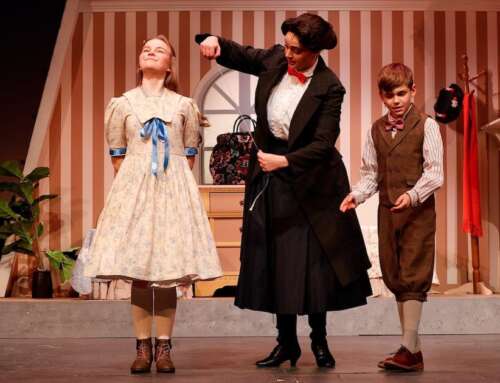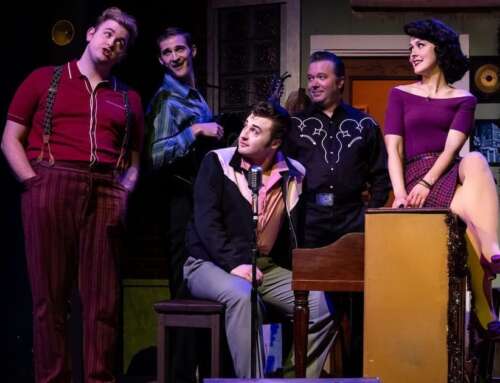At the Denver Center, ‘Quixote Nuevo’ imagines a hero for today’s borderlands
Don Quixote is literature’s original hero-doofus — a character with the passion and determination to attempt fixing the world but without any skill or power to effect much change. As such, he comes across as inept — but in a sympathetic way. Cervantes wrote Don Quixote for 17th-century Spain, but playwright Octavio Solís is well justified in refreshing the character for the modern-day borderlands between Texas and Mexico.
There may be few places on Earth where hope and despair run so closely parallel to each other, and who better to illustrate it with a bit of humor than the original windmill tilter? In Quixote Nuevo, directed by Lisa Portes and now showing in the Denver Center’s Wolf Theatre, we meet José Quijano (Herbert Siguenza) — a retired literature professor and Cervantes scholar who’s about to be shuffled off to the old-folks home by his sister Magdalena (Laura Crotte). Rather than succumb to eking out his remaining days at an “assisted dying” home, he morphs into Don Quixote and sets out to do … something.
With a hubcap and license plates for armor, a trike fitted with a bleached cow skull for a steed and a bedpan for a helmet, he sets out from his home in La Plancha, Texas to find his lost love Dulcinea and perhaps right some wrongs along the way.

Raúl Cardona as Papa Calaca and his death angels in the Denver Center Theatre Company production of ‘Quixote Nuevo’ | Photo: Adams VisCom
Quijano is clearly suffering from some level of dementia, and he bounces between near-full lucidity and batshit crazy. As he blusters and bungles his way through the borderlands, his disregard for the rules allows him to veer outside the lines of docility and take on, among other things, the Border Patrol. Walls — including “The Wall” of a previous president’s obsession — figure prominently in the story. One separates life from death, and while this Quixote is still very full of the former, death is a constant presence in the form of Papa Calaca (Raúl Cardona). Bare chested in a leather jacket, black pants and hat, Calaca is there at the top of the show with his choir of dark angels — six or so Calacas in death masks who pop up out of the floor or from the wings to stomp, sing and shout in a number of high-energy scenes.
Loud though they are, Quixote manages to keep them at bay as he pursues Dulcinea, eventually soliciting help from his Sancho Panza — a popsicle vendor named Manny (a very funny Ernie González, Jr.). Together, the two come across clues that suggest Dulcinea died in the desert, but hope continues to drive the quest forward while delivering the characters into a number of complicated situations.
It’s a tight, well-wrought production that benefits from all the power of the Denver Center’s team: great costumes, lights, sound, effects, choreography and more. For so colorful a play on the exterior, some of the characters still come across as two dimensional — particularly the women. Magdalena is just a bossy matriarch, while Crotte’s other character — a bar whore named Perla — is merely a stereotype. Maya Malan-Gonzalez plays a therapist who’s been seeing José, but she doesn’t have a lot to do as this character or as Dulcinea later on. Krystal Ortiz plays the caring niece and also a bar employee, but neither are particularly interesting despite perfectly fine acting.
At nearly three hours (with a 15-minute intermission), Quixote Nuevo wears out its welcome about halfway through the second act, when the scenes of our hero doing crazy shit and everyone around him reacting to it start to blend together.
But even as the script wanders off, there’s a lot to think about in terms of how this Don Quixote sees things in the 21st century. While the despair in this part of the world is real, the fact that a hero — even one as ridiculous as José in his bedpan helmet — can inspire the downtrodden does offer that glimmer of hope. Despite there perhaps being a few too many of them, a number of the scenes imagined by Solís beautifully rework the Cervantes tale over the centuries, with a poignancy that puts a lot of heart behind the stories we hear in the news about one shitty situation after another on the southern border.
Alex Miller is editor and publisher of OnStage Colorado. He has a long background in journalism, including stints as the top editor at the Vail Daily, Summit Daily News, Summit County Journal, Vail Trail and others. He’s also been an actor, director, playwright, artistic director and theatre board member and has been covering theatre in Colorado since 1995.






Leave A Comment